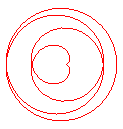EPICYCLOID

| next curve | previous curve | 2D curves | 3D curves | surfaces | fractals | polyhedra |
EPICYCLOID

| Curve studied by Hipparchus in the 2nd century BC, Dürer
in 1525, RØmer in 1674
and Daniel Bernoulli in 1725.
Prefix coming from the Greek epi "over". |
The epicycloids are the curves described by a point on a circle (C) rolling without slipping on a base circle (C0), the open disks with boundaries (C) and (C0) being disjoint. Therefore, they are special cases of epitrochoids.

| Complex parametrization: where a is the radius of the base circle and Cartesian parametrization: Vector radius: Curvilinear abscissa given by  ) )
Two possible expressions for the curvilinear abscissa: 1) Cartesian tangential angle: Radius of curvature: Intrinsic equation 1: ( Intrinsic equation 2: |
The epicycloids are the curves composed of isometric arcs
(the arches) joining at cuspidal points (obtained for )
in a finite number equal to the numerator of q if q is rational,
or in an infinite number otherwise.
When q is rational, ,
the curve is algebraic and rational (take
as a parameter).
Its looks like a regular polygon, crossed if m³
2, with
n vertices joined m points by m points by
the curves located outside the circle (C0).
The notation of simple epicycloid with n cusps
(En) refers to the case q
= n, i.e. when there are no crossovers.

q = 1: cardioid |

q = 2: nephroid |

q = 3 |

q = 4 |

q = 5 |

q = 1/2: double cardioid |

q = 3/2 |

q = 5/2 |

q = 7/2 |

q = 9/2 |

q = 1/3 |

q = 2/3 |

q = 4/3 |

q = 5/3 |

q = 7/3 |

q = 1/4 |

q = 3/4 |

q = 5/4 |

q = 7/4 |

q = 9/4 |

q = 1/5 |

q = 2/5 |

q = 3/5 |

q = 4/5 |

q = 6/5 |
| The epicycloid is also the curve described by a point
on a circle with radius |
 |
The epicycloid is the envelope of a diameter of a circle with radius twice that of (C), rolling without slipping on (C0) externally.
It is also the envelope of a chord (PQ) of the
circle with radius a + 2b (circle of the vertices of the
epicycloid), while P and Q describe this circle in the same
direction with the speed ratio constant and equal to q + 1 (this
constitutes the Cremona generation).
Therefore, if we consider that planets have uniform circular
movements on a plane around the Sun, the line that joins two planets envelopes
an epicycloid (see, for example, this
video).
It is finally the negative
pedal with respect to O of the rose: .
| Its evolute
is its image by the direct similarity with centre O, ratio |
 |
One of its involutes is therefore a similar epicycloid;
when the numerator of q is odd, the other involutes are auto-parallel
curves.
| Epicycloids can also be defined as the trajectories of
a movement that is the sum of two uniform circular motions with same speed
and in the same direction (with complex parametrization: |
 |
| The epicycloid is also the symmetric
curve of the hypocycloid
traced with the same circle.
For example, opposite, the epicycloid with 4 cusps is the symmetric curve of the astroid. |
 |
Epicycloids are also a special case of cycloidal curve, along with hypocycloids and the cycloid.
They also are the projections of spherical helices.
The differential equation 
We also find the epicycloids as the principal components
of the Mandelbrot
sets associated to .
See also in 3D the spherical epicycloids.

| next curve | previous curve | 2D curves | 3D curves | surfaces | fractals | polyhedra |
© Robert FERRÉOL, Jacques MANDONNET 2017